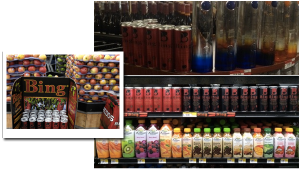22 May How to Successfully Cross Merchandise in any Aisle
The Art of Cross Product Promotion
Cross merchandise is an art form that involves far more than a grocery store manager deciding where to pair bananas with cereal displays. “Cross merchandise is important because people buy solutions, not products, and retailers tend to sell products, not solutions. So they need to combine things that tend to cross departments,” says Neil Stern, senior partner with McMillan Doolittle, a retail consulting firm in Chicago (source: about.com).
“In general, placement can lift the sales of different items,” Venky Shankar, professor of marketing at the Mays Business School at Texas A&M University, told United Press International (source: Retail Now case study). “It’s true across the board, but the amount depends on categories.”
Why It Works
A case in point is the pairing of chips and soda pop. When displayed adjacent to one another, soft drink sales increased up to 9% while chips remained the same. “If you are shopping for chips, you may remember you get thirsty when you eat them, so you buy soda,” Prof. Shankar told UPI. “But if you stop at a gas station because you’re thirsty, you probably aren’t going to buy chips.” (source: UPI)
At West Point Market in Akron, Ohio, produce shoppers can sample new-crop autumn apples with cubes of cheddar, an experience that boosts sales of both. At Central Markets in Texas, the cheddar is pre-cut into approximately $6 portions and displayed atop of an uncut block of cheddar alongside apples to prompt an impulse purchase (source: Specialty Food Association).
Pre-cut Gruyère with Anjou pears also tempts Central Market shoppers. “We see huge jumps in sales when we put cheese in produce,” says Debbie Harris, cheese merchandiser for the 10 New Seasons Markets, all in the Portland, Ore., area. Aged Gouda in pre-cut $4 portions sells well when merchandised with apples and pears and can remain un-refrigerated longer than cheddar’s, Harris says. (source: Specialty Food Association).
Keys to Success
To achieve success with cross merchandise there are four ingredients that are critical to making your display work:
Correlation: Group together products that are related in some way. For instance, an electronics retailer might display some popcorn or beverages near DVDs and Blu-Ray movies.
Relevance: Create your product display around a central theme. Cluttering it with unrelated products and no main theme will only reduce its effectiveness as a marketing tool.
Performance: After setting up any cross-merchandising display, pay close attention to your sales in the weeks and months to follow. If it’s not performing well, don’t be hesitant to make some changes.
Profiling: Think like a customer. Ask yourself — does this display make me want to buy the product? If you answered no, it’s probably time to re-think your product display.
The Takeaway
In the end, cross merchandising is much more than the rearranging of products from one department to another. It’s all about creating a theme – ultimately finding and promoting the thread that ties the featured products together.
When done right, cross-merchandising can drive more sales and higher profits. It’s a simple marketing technique that nearly all of the nation’s top retailers use and a strategy that Fresh Source leverages for many of its product vendors.



